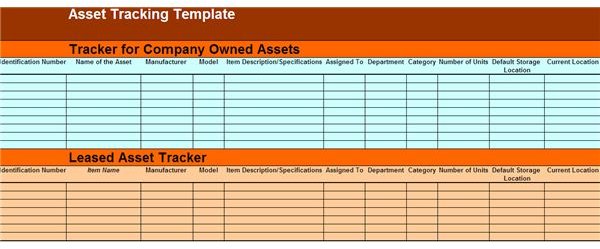Manage Asset Inventory with this Excel Asset Tracking Template
Assets are valuable as well as indispensable for any project or business – and thus a suitable asset tracking system is needed for safekeeping them. This is where this free excel asset tracking template, which can be downloaded from Bright Hub’s Media Gallery, will come in handy for maintaining a proper inventory of all the assets. The template is fairly simple to use, nonetheless we have detailed instructions on how to use it and the kind of information that should be stored for each and every asset. While most asset tracking systems have provision for tracking owned assets, we’ve added an additional section to the same template, to keep record of the assets taken on lease. The basic information that you need to fill in about the asset remains the same across both the sections and only the last few fields are different depending on the ownership of the asset. Thus the instructions here have been divided into three sections to make things easier.
Basic Information About the Asset
Identification Number: Every type of asset should be assigned a unique identification number for tracking purposes. For instance all desktop computers can be assigned a single identification number. And in case you’re using different configurations or different models, like desktops with Intel P-IV processor or with Intel Celeron 2.0 GHz processor, then each type can be assigned a different identification number. The identification numbers will make it easier to search through the database.
Name of Asset/ Item Name: Here you can enter the commonly used name for the asset like desktop computer, laptop, printer, router, office table etc.
Manufacturer: This is where you can put in either the brand name or the name of the manufacturer of the asset. The idea in having the manufacturers name recorded is to be able to contact the manufacturer or its service agency in case of a problem. This is essentially needed only for electronics and equipment, so for other assets where a clearly identifiable manufacturer doesn’t exist or where the manufacturer doesn’t promise any after sales services this field can be left blank. For instance – office furniture picked up from some local furniture shop.
Model: If there is a particular model number or name for the asset, like Sony Vaio, Dell Inspiron 15R or HP PSC1410, it should be
mentioned under this column.
Item Description/Specifications: All additional item details can be added to this field. For instance, for a desktop computer – information about its processor, RAM, hard disk etc can be stored here.
Assigned To: This is where the name of the person to whom the asset has been assigned should be recorded. The person whose name is mentioned here will be fully accountable for safekeeping the asset.
Department: Here goes the name of the department, like human resource, finance, administration, production etc, which is currently using or storing the asset.
Category: The user can make a customized list of the type of assets and categorize each asset under one of these types. Some examples of categories are – computers, electronic equipments, furniture, storage, machinery etc.
Number of Units: This field is self explanatory and you just need to put in the number of units of a particular asset.
Default Storage Location: Every asset, especially the ones that are frequently moved from one location to another, must have a defined default storage location where they should be stored when not in use.
Current Location: This field is meant for recording the current location of the asset. For all assets that are permanently assigned to a particular department or office the default storage location and the current location will remain the same and thus this field can be left blank.
Additional Details Required for Owned Assets
Purchase Price: This is the price at which the asset was purchased.
Purchase Date: Here goes the date of on which the asset was purchased.
Warranty Expiry Date: The warranty expiry date needs to be filled up only if the asset is still in the warranty period.
Insurance Details: If some asset is protected with insurance, the details of this can be mentioned in this column. Putting in the name of the insurance company and the insurance policy number will serve the purpose.
Insurance Renewal Date: If the asset is insured, the renewal date of the policy can be mentioned here.
Additional Details Required for Leased Assets
The second half of the excel asset tracking template is reserved for keeping track of assets that have been taken on lease. And besides the basic information regarding the asset, the additional details required are:
Leasing Firm: The name of the firm from which the asset has been taken on lease can be recorded in this field.
Lease Amount: This is simply the lease amount as mentioned in the lease contract.
Type of Lease: There are different types of lease agreements like direct lease, finance lease, operating lease, and leveraged lease etc. Each lease type has a unique set of risks, conditions and payment structure, thus it’s important to mention it on the asset tracking sheet.
Lease End Date: The last piece of information that goes into this asset tracking sheet is the end date for the lease agreement. It should be noted for every item taken on lease, so that the management can make timely arrangements for the replacement of the asset.
References & Credits:
- https://www.mycroftcomputing.com/eiown/asset-tracking-software.html
- https://www.pbog.com/index.php?page=article&article=41
- https://office.microsoft.com/en-us/templates/asset-tracking-database-TC001018459.aspx
Image Credit:
Image by – Sidharth Thakur
